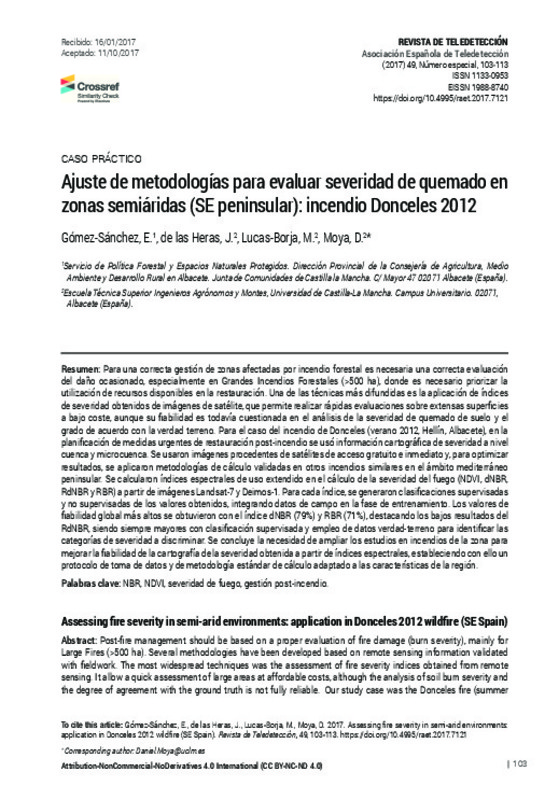Alloza, J. A., García, S., Gimeno, T., Baeza, M.J., Vallejo, V.R. 2014. Guía técnica para la gestión de montes quemados. Madrid: Ministerio de Agricultura, Alimentación y Medio Ambiente.
Chavez, P.S. 1996. Image-based atmospheric corrections. Revisited and improved. Photogrammetric Engineering and Remote Sensing, 62, 1025-1036.
Chuvieco, E. (Ed.). (1999). Remote Sensing of Large Wildfires. doi:10.1007/978-3-642-60164-4
[+]
Alloza, J. A., García, S., Gimeno, T., Baeza, M.J., Vallejo, V.R. 2014. Guía técnica para la gestión de montes quemados. Madrid: Ministerio de Agricultura, Alimentación y Medio Ambiente.
Chavez, P.S. 1996. Image-based atmospheric corrections. Revisited and improved. Photogrammetric Engineering and Remote Sensing, 62, 1025-1036.
Chuvieco, E. (Ed.). (1999). Remote Sensing of Large Wildfires. doi:10.1007/978-3-642-60164-4
Chuvieco, E. (Ed.). (2009). Earth Observation of Wildland Fires in Mediterranean Ecosystems. doi:10.1007/978-3-642-01754-4
Escuin, S., Navarro, R., & Fernández, P. (2007). Fire severity assessment by using NBR (Normalized Burn Ratio) and NDVI (Normalized Difference Vegetation Index) derived from LANDSAT TM/ETM images. International Journal of Remote Sensing, 29(4), 1053-1073. doi:10.1080/01431160701281072
Fontúrbel, M. T., Fernández, C., Vega, J. A. 2015. Cambios en la repelencia al agua del suelo en función de la severidad del fuego en el suelo. Flamma, 6(3), 122-124
González De Vega, S., de las Heras, J., Gómez-Sánchez, E., Moya, D. 2015. Response of plant communities in the short-term after fire: influence of fire severity and resilience. Flamma, 6(3), 149-153.
Keeley, J. E. (2009). Fire intensity, fire severity and burn severity: a brief review and suggested usage. International Journal of Wildland Fire, 18(1), 116. doi:10.1071/wf07049
Key, C. H., Benson, N. C. 2005. Landscape assessment: Remote sensing of severity, the Normalized Burn Ratio. In D. C. Lutes (Ed.), FIREMON: Fire effects monitoring and inventory system. General Technical Report, RMRSGTR-164-CD:LA1-LA51. Ogden, UT: USDA Forest Service, Rocky Mountain Research Station.
Llovería, R. M., Cabello, F. P., Martín, A. G., Vlassova, L., de la Riva Fernández, J. R. 2014. La severidad del fuego: revisión de conceptos, métodos y efectos ambientales. In Geoecología, cambio ambiental y paisaje: homenaje al profesor José María García Ruiz, 427-440. Instituto Pirenaico de Ecología.
Malak, D. A., Pausas, J. G., Pardo-Pascual, J. E., & Ruiz, L. A. (2015). Fire Recurrence and the Dynamics of the Enhanced Vegetation Index in a Mediterranean Ecosystem. International Journal of Applied Geospatial Research, 6(2), 18-35. doi:10.4018/ijagr.2015040102
Miller, J. D., & Thode, A. E. (2007). Quantifying burn severity in a heterogeneous landscape with a relative version of the delta Normalized Burn Ratio (dNBR). Remote Sensing of Environment, 109(1), 66-80. doi:10.1016/j.rse.2006.12.006
Moya, D., De las Heras, J., López-Serrano, F. R., Condes, S., & Alberdi, I. (2008). Structural patterns and biodiversity in burned and managed Aleppo pine stands. Plant Ecology, 200(2), 217-228. doi:10.1007/s11258-008-9446-6
Paula, S., Arianoutsou, M., Kazanis, D., Tavsanoglu, Ç., Lloret, F., Buhk, C., … Pausas, J. G. (2009). Fire-related traits for plant species of the Mediterranean Basin. Ecology, 90(5), 1420-1420. doi:10.1890/08-1309.1
Parks, S., Dillon, G., & Miller, C. (2014). A New Metric for Quantifying Burn Severity: The Relativized Burn Ratio. Remote Sensing, 6(3), 1827-1844. doi:10.3390/rs6031827
Pausas, J. G. (1999). Plant Ecology, 140(1), 27-39. doi:10.1023/a:1009752403216
Regueira, N., Benito, E., Fontúrbel, M. T., Fernández, C., Jiménez, E., Vega, J. A. 2015. Efectos de quemas experimentales de diferente severidad en el carbono orgánico y en propiedades físicas del suelo. Flamma, 6(3), 129-133.
San-Miguel-Ayanz, J., Camia, A. 2009. Forest fires at a glance: facts, figures and trends in the EU. In: Birot, Yves (Ed.), Living with Wildfires: What Science Can Tell Us. A Contribution to the Sciencepolicy Dialogue. Joensuu, Finland: European Forest Institute, 11–18.
Soverel, N. O., Perrakis, D. D. B., & Coops, N. C. (2010). Estimating burn severity from Landsat dNBR and RdNBR indices across western Canada. Remote Sensing of Environment, 114(9), 1896-1909. doi:10.1016/j.rse.2010.03.013
Spano, D., Camia, A., Bacciu, V., Masala, F., Duguy, B., Trigo, R., Sousa, P., Venäläinen, A., Mouillot, F., Curt, T., Moreno, J. M., Zavala, G., Urbieta, I. R., Koutsias, N., Xystrakis, F. 2014. Recent trends in forest fires in Mediterranean areas and associated changes in fire regimes. In: Moreno, J. M., Arianoutsou, M., González-Cabán, A., Mouillot, F., Oechel, W. C., Spano, D., Thonicke, K., Vallejo, V. R., Vélez, R. (Eds.), Forest Fires Under Climate, Social and Economic Changes in Europe, the Mediterranean and other Fire-affected Areas of the World. FUME. Lesson Learned and Outlook. 6–7.
Tessler, N., Wittenberg, L., Provizor, E., & Greenbaum, N. (2014). The influence of short-interval recurrent forest fires on the abundance of Aleppo pine (Pinus halepensis Mill.) on Mount Carmel, Israel. Forest Ecology and Management, 324, 109-116. doi:10.1016/j.foreco.2014.02.014
Tou, J. T., Gonzalez, R. C. 1974. Pattern Recognition Principles. Reading, Massachusetts: AddisonWesley Publishing Company.
Richards, J. A., & Jia, X. (1999). Remote Sensing Digital Image Analysis. doi:10.1007/978-3-662-03978-6
Rivas-Martínez, S. 1982. Estage bioclimatiques, secteurs chorologiques et série de vegetation de l'Espagne méditerranéenne. Ecología Mediterranea 8, 275–288.
Rodríguez Ramos, N., Galano Duverger, S., Belloch García, I., Estrada, R., Martín Morales, G. 2009. Rellenado de los gaps provocados por la falla del Scan Line Corrector en las imágenes Landsat 7 ETM+. Universidad de La Habana. 49 pp.
Vega, J. A., Fontúrbel, T., Fernández, C., Díaz-Ravi-a, M., Carballas, T., Martín, A., González-Prieto, S., Merino, A., Benito, E. 2013. Acciones urgentes contra la erosión en áreas forestales quemadas. Guía para su planificación en Galicia. Santiago de Compostela: Centro de Investigación Forestal de Lourizán, Consellería do Medio Rural e do Mar, Xunta de Galícia, Instituto de Investigaciones Agrobiológicas de Galicia del CSIC (IIAGCSIC), Universidad de Santiago de Compostela, Universidad de Vigo, FUEGORED.
Viera, A. J., Garrett, J. M. 2005. Understanding interobserver agreement: The kappa statistic. Family Medicine, 37(5), 360–363.
Vlassova, L., Pérez-Cabello, F., Mimbrero, M., Llovería, R., & García-Martín, A. (2014). Analysis of the Relationship between Land Surface Temperature and Wildfire Severity in a Series of Landsat Images. Remote Sensing, 6(7), 6136-6162. doi:10.3390/rs6076136
[-]








